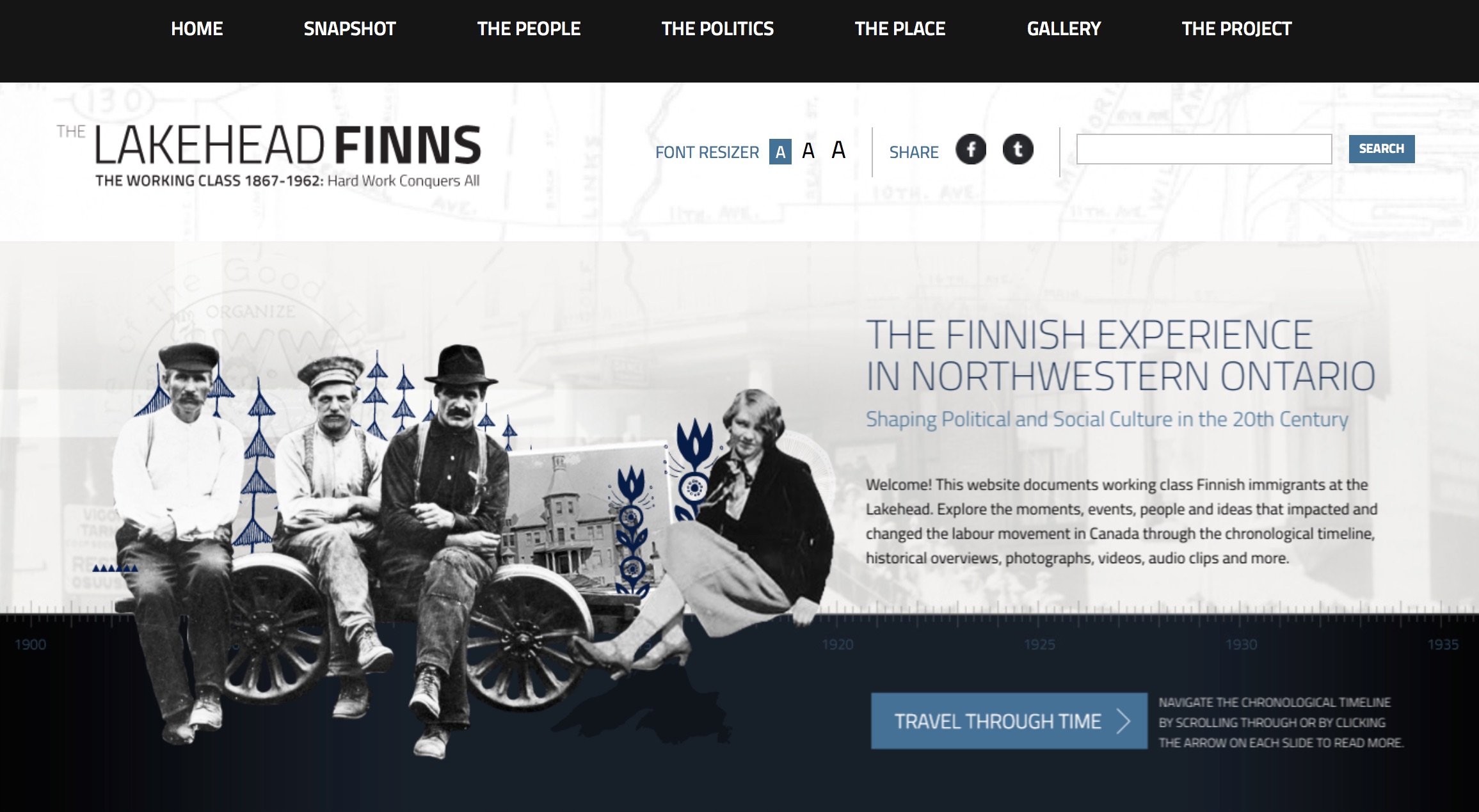Exhibits, Film, & Media Projects
Where the Poppies Grow: The Lakehead at War (2018) |
The Lakehead Finns - The Working Class 1900-35: "Hard Work Conquers All" (Beta English, Finnish, and French Versions 2016, Final in progress)Educational Website - http://lakeheadfinns.ca/ Funded by the Social Science and Humanities Research Council of Canada (SSHRC), The Lakehead Finns allows users to explore the Finnish experience and Finnish working-class culture in Canada. It is intended to assist Canadians understand the place of Finnish immigrants in the annals of the history of the Canadian labour movement and the political evolution of Canadian society. Through text, oral testimonies, and video the story of how Finnish immigrants brought to Canada their experiences with Tzarist Russia and the Russian Revolution and how their politics shaped the Canadian left is outlined. It will eventually be available in French, English, and Finnish.
|
Under the Red Star (2011)Docudrama, 78 min, ShebaFilms Based on my book Labour at the Lakehead, "Under the Red Star" is a feature length docu-drama, in Finnish and English, about the vibrant culture and politics at the heart of Canada’s largest labour hall. In 1910, Finnish immigrants built the Finnish Labour Temple in Port Arthur, Ontario (now Thunder Bay). In its early days it was inseparably linked to the activities of Canadian labour and the left. The Big Finn Hall was a place where culture and politics came together. This film integrates archival footage, photos and fictionalized scenes to bring to life the lively and dramatic past of the early years of Finnish immigration to Canada. "Under the Red Star" tells the story of the struggle for a just society in the early twentieth century Canada.
|
Life is But a Dream.... (2010)Documentary, 7 min, Flash Frame & Shebandowan Films “Life Is But A Dream…” is about nationally renowned author Charlie Wilkins who is getting ready to row across the Atlantic Ocean at the end of 2010. Selected as one of the 12 finalists for International Documentary Challenge and screened at Hot Docs. Click here to view the film on the Doc Challenge website.
Major Festivals and Broadcast:
|
Dorothea Mitchell: A Reel Pioneer (2006)Documentary, 52min, Shebandowan Films Dorothea Mitchell was born in Britain, raised in India and immigrated to Canada in 1904. After settling in Northwestern Ontario she became the first single woman to be granted a homestead in Ontario, and became the first woman in Canada to make independent films. Along the way, she became known as the Lady Lumberjack and later distinguished herself as an author. Based on my research for Celluloid Dreams: An Illustrated History of Early Film at the Lakehead and Lady Lumberjack: An Annotated Collection of Dorothea Mitchell's Writings, "A Reel Pioneer" is a film about Dorothea Mitchell and the Port Arthur Amateur Cinema Society. Together, they made the first feature-length amateur film in Canada and their story, told through the eyes of Dorothea Mitchell, is brought back in the form of a historical documentry. Dorothea Mitchell's story is an inspiration to women everywhere. "A Reel Pioneer" is currently being broadcast in Canada on the BRAVO! channel. |
www.ladylumberjack.ca (2005)
Educational Website - http://www.ladylumberjack.ca In only two years, (1929-1930), Dorothea Mitchell and the Port Arthur Amateur Cinema Society produced three feature-length films in what is now Thunder Bay, Ontario. The historical importance of the films made by the Port Arthur Cinema Society is second to none. This website uses these examples to assist teachers of Media Studies in the instruction of filmmaking, and to explore a little-known chapter in Canada's filmmaking history. This project was funded in part by the Department of Canadian Heritage and produced with the assistance of the Audio-Visual Preservation Trust. |
Port Arthur Cinema Society Collection (2005)Three Silent Films, 47 min, 25 min, and 49 min, DVD Although short-lived, the Port Arthur Amateur Cinema Society, the first such organization in Canada, made three feature-length films in less than two years. This included "A Race for Ties" the first amateur feature-length film in Canada. The complete collection of the extant works of the Port Arthur Amateur Cinema Society. The digitally preserved set includes A Race for Ties (1929), Sleep-Inn Beauty (1929); and The Fatal Flower (1930; 2004). |
The Fatal Flower (1930; 2004)Silent Film, 49 min, Flash Frame & Shebandowan Films A feature length silent film, shot by the Port Arthur Amateur Cinema Society in 1930, but not finished because of the onset of the Depression and the advent of "talkies." The raw footage was preserved in the Library and National Archives of Canada until it was "discovered" in 2000. In an effort to pay tribute to Canada's filmmaking pioneers and to learn the technique of silent film, an enthusiastic group of people interested in film history pooled their talents to complete The Fatal Flower in 2004. Their efforts paid off in the form of a 45 minute murder mystery complete with an original musical score.
|


 30 min, Docudrama, available in English and French
30 min, Docudrama, available in English and French
